This form is used by a trustee on a trust deed when foreclosure on a property has been commenced by recording a notice of default (NOD) and three months have passed without the property owner curing the defaults, to prepare and record a notice of trustee’s sale.
Nonjudicial foreclosure
A trust deed is a security device which imposes a lien on real estate. [See RPI e-book Real Estate Principles Chapter 69]
A trust deed has three parties:
- at least one trustor (the owner(s) of the secured real estate);
- a trustee (one who holds title to the real estate in trust for another); and
- at least one beneficiary (a lender, carryback seller, homeowners’ association (HOA) or another lienholder).
A nonjudicial foreclosure sale, also called a trustee’s sale, is conducted by the trustee who is either:
- named in the trust deed; or
- appointed by the beneficiary of the trust deed when the beneficiary initiates the foreclosure process.
The trustee begins foreclosure by recording a notice of default (NOD). [See RPI Form 412]
At least 30 days prior to recording an NOD on a trust deed securing a purchase-assist mortgage on a borrower’s principal residence, a mortgage holder needs to conduct a pre-foreclosure workout with the owner to explore options for the owner to avoid foreclosure and provide financial counseling to the owner. [See RPI e-book Real Estate Finance Chapter 44]
The key to the trust deed holder’s ability to nonjudicially foreclose by a trustee’s sale on the secured real estate is the power-of-sale provision contained in the trust deed. [See RPI Form 450 §3.6]
The nonjudicial foreclosure process has three stages:
- the NOD is recorded and mailed;
- the notice of trustee’s sale (NOTS) is recorded, posted and mailed [See RPI Form 474]; and
- the trustee’s sale of the real estate by auction.
The notice of trustee’s sale
A trustee or beneficiary may begin noticing the date set for the sale of a property on the day following three months after the NOD is recorded. [CC §2924]
The trustee prepares an NOTS which contains:
- the trustee’s name or their agent’s name, street address and telephone number (or toll-free number when located out of state);
- the street address or common designation of the secured property;
- the county assessor’s parcel number of the secured property;
- the dollar amount of the debt in default, including reasonably estimated advances for hazard insurance premiums, property taxes due and foreclosure costs; and
- a statutory statement informing the owner they are in default. [CC §2924f; See RPI Form 474]
In general practice, a date down of the trustee’s sale guarantee issued to the trustee is ordered out from the title company the day before or on the day the title company records the NOTS.
The date down notifies the trustee of any interests recorded on the title to the property after the NOD is recorded. However, the trustee is not required to give notice of the impending trustee’s sale to any person who recorded an interest in the property after the NOD was recorded. [CC §2924b(c)(1)]
Delivery of the NOTS
At least 20 calendar days before the trustee’s sale, the trustee sends two copies of the NOTS to each party the trustee previously sent the NOD. [CC §2924b(c)(3)]
In addition to mailing the notice to all the interested parties of record, the trustee performs all the following steps at least 20 calendar days prior to the sale:
- posting a copy of the NOTS in one public place in the city of the sale, or when the sale is not held in a city, the judicial district in which the property is being sold;
- posting a copy of the NOTS in a conspicuous place on the property to be sold; and
- publishing a copy of the NOTS once a week for three consecutive calendar weeks in a newspaper of general circulation in the city where the property is located. [CC §2924f(b)(1)]
A trustee or beneficiary uses the Notice of Trustee’s Sale (NOTS) form published by RPI when notifying a delinquent owner or junior lienholder they are in default and that, unless they take action to protect their property, it may be sold at a public sale to the highest bidder. [See RPI Form 474]
Like the NOD, the NOTS needs to contain a summary of key information in the language the mortgage was originally negotiated in. [CC §2923.3; See RPI Form 474-3 through 474-7]
A trustee’s sale may be postponed by the trustee at any time prior to the completion of the foreclosure sale. The trustee’s sale may be postponed on the instruction of the mortgage holder or by the trustee at their discretion. [CC §2924g(c)(1)]
Form navigation page published 08-2021.
Form last revised 2016.
Form-of-the-Week: Request for Notice of Default (NOD) and Notice of Trustee’s Sale (NOTS) – Forms 412 and 474
Word-of-the-Week: Nonjudicial foreclosure
Video: The Notice of Trustee’s Sale
Article: Trustee’s sale procedures
Article: Trustee’s sale procedures, c’td
Article: Accepting partial payments after default
Recent Case Decision: Is a verbal agreement to postpone a sale enforceable against foreclosure?
Recent Case Decision: Does a trust deed holder owe a duty to a title insurance company who relies on a forged trustee’s deed?













